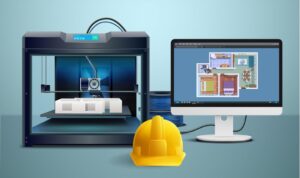Building a New World: The Resplendent Revolution of 3D Printed Homes in Construction
The construction industry has witnessed a remarkable transformation in recent years, propelled by the advent of 3D printing technology. This promising innovation has redefined the traditional methods of building homes, opening up a world of once unimaginable possibilities.
At its core, 3D printing in the context of construction involves the process of creating three-dimensional objects layer by layer using advanced computer-controlled machines. However, when applied to the construction industry, this technology takes on a whole new dimension.
Definition of 3D printing in the context of construction
In the realm of construction, 3D printing encompasses various techniques that employ specialized machines to fabricate entire structures or components thereof with precision and efficiency. These machines typically utilize materials like concrete or plastic to build layer upon layer, following computer-generated designs with remarkable accuracy. This disruptive technology allows for unprecedented levels of customization and complexity in architectural designs while considerably reducing the time and costs associated with traditional construction methods.
Brief history and evolution of 3D printing technology
The roots of 3D printing can be traced back to as early as the 1980s, when Chuck Hull invented stereolithography—a technique that allowed for additive manufacturing by curing thin layers of liquid plastic using ultraviolet light. This breakthrough laid the foundation for what would become one of the most revolutionary technological advancements across industries, including construction.
Over time, researchers and engineers developed various other additive manufacturing techniques such as fused deposition modeling (FDM), selective laser sintering (SLS), and binder jetting—each offering unique advantages and enabling diverse applications within different sectors. The evolution was rapid, leading to improvements in both hardware and software components crucial for expanding the capabilities and scalability of 3D printers.
While initially used primarily for prototyping purposes due to limitations in material strength and size, the technology gradually matured to address these challenges. In recent years, significant breakthroughs have been made in the development of large-scale 3D printers capable of building entire homes, marking a pivotal moment in the construction industry’s transformation.
The emergence of 3D printing in the construction industry has revolutionized the way homes are built, offering numerous benefits and possibilities.
The integration of 3D printing into the construction industry has sparked a profound revolution that is reshaping traditional practices and challenging age-old assumptions. With its ability to construct full-scale habitable structures with unprecedented speed and precision, 3D printing holds immense potential for transforming how we approach housing needs. This article aims to explore the various advantages, technological innovations, and far-reaching implications that stem from this remarkable convergence of architecture and additive manufacturing.

Overview of 3D Printing in Construction
Unleashing the Power of Technology and Innovation
The advent of 3D printing technology has brought forth a paradigm shift in the construction industry. Essentially, 3D printing, also known as additive manufacturing, involves the layer-by-layer creation of three-dimensional objects based on digital designs.
In the realm of construction, this cutting-edge technology has opened up a new realm of possibilities. By employing specialized printers capable of working with various materials, such as concrete or plastic, entire homes can be constructed with unprecedented precision and efficiency.
Different Types of Materials for 3D Printed Homes
One remarkable aspect of 3D printed homes is their versatility in material usage. While traditional construction methods primarily revolve around bricks, wood, or steel frameworks, 3D printing has introduced a wide array of materials suitable for building homes.
The most commonly used material is concrete due to its durability and cost-effectiveness. Specialized cement mixtures are formulated to ensure optimal flowability within the printer nozzles while maintaining structural integrity upon solidification.
In addition to concrete, other materials like plastic polymers have also been successfully employed in creating lightweight structures that still adhere to necessary safety standards. These innovative materials allow for greater flexibility in architectural design while maintaining functionality.
Traditional Construction vs. 3D Printing
When examining traditional construction methods alongside 3D printing technology within the context of homebuilding, striking differences emerge between these two approaches. In traditional construction methods, human laborers actively engage in various stages like bricklaying or framework assembly—processes that are time-consuming and physically demanding. Conversely, with 3D printing technology employed for constructing homes, robotics and automated systems take centre stage. This eliminates the need for extensive manual labor, dramatically reducing construction timeframes while minimizing the risk of human error. Moreover, traditional construction methods often generate significant waste material from excess bricks, concrete, or timber. On the contrary, 3D printing maximizes resource efficiency by utilizing only the necessary amount of materials required for each layer. This not only minimizes waste but also substantially reduces costs associated with material acquisition and disposal. Overall, the introduction of 3D printing in construction showcases a transformative leap in efficiency and sustainability when compared to conventional building techniques.
Advantages and Benefits of 3D Printed Homes
Cost-effectiveness: Reduced labor costs, minimal waste material, and efficient use of resources
The use of 3D printing technology in construction offers a myriad of cost-saving benefits. One major advantage is the significant reduction in labor costs.
Traditional construction methods require a large workforce, involving skilled craftsmen for various tasks such as bricklaying, plumbing, and electrical work. In contrast, 3D printed homes rely on automated machines that can execute these tasks with precision and speed.
This eliminates the need for extensive manual labor and reduces overall expenses. Furthermore, 3D printing minimizes waste material as it operates on an additive manufacturing principle.
Unlike traditional construction, where excess materials often end up as debris or discarded scraps, 3D printers only utilize the necessary amount of material required for each layer. This results in less waste generation during the construction process.
Efficient use of resources is another key benefit offered by 3D printed homes. By accurately calculating the exact quantity of materials needed for each structure, there is a significant reduction in resource consumption compared to traditional methods where estimations are often made, leading to overuse or underuse of materials. Example case studies showcasing cost savings achieved through 3D printed homes:
One notable case study comes from Apis Cor, a company specializing in mobile construction 3D printing technologies. They demonstrated how their technology reduced construction costs by up to 70% compared to conventional building methods in a project they undertook in Russia. By utilizing their portable printer on-site with minimal labor requirements, they were able to construct a fully functional house within just 24 hours while achieving substantial cost savings.
Speed and efficiency: Rapid construction process compared to traditional methods
One undeniable advantage of constructing homes using 3D printing technology is the remarkable increase in speed and efficiency. Traditional construction methods often involve a prolonged timeline due to the sequential nature of tasks such as foundation preparation, wall construction, and interior finishing.
In contrast, 3D printing technology allows for the simultaneous execution of multiple tasks, resulting in significantly reduced construction time. To put this into perspective, let’s compare the time required for traditional home construction versus 3D printed homes.
A conventional two-story house may take several months to complete, involving various stages that are subject to weather conditions, labor shortages, and other unforeseen delays. In contrast, 3D printed homes can be constructed within a matter of days or even hours, depending on their size and complexity.
Real-life examples further demonstrate the speed advantage of using 3D printing technology. For instance, in 2018, a company called ICON partnered with New Story Charity to build affordable homes using their Vulcan printer.
They completed an entire community of 50 houses in Tabasco Mexico within just a few months. This project showcased how 3D printing technology not only expedites the construction process but also provides solutions for addressing housing shortages in impoverished regions.
Design flexibility: Freedom to create complex architectural designs with ease
One of the most intriguing aspects of utilizing 3D printing technology in home construction is the unparalleled design flexibility it offers. Traditional building methods often come with limitations regarding architectural creativity due to constraints posed by manual labour and material constraints. With 3D printers capable of fabricating intricate structures layer by layer, architects have newfound freedom to explore unconventional and complex designs that were previously unattainable or cost-prohibitive.
The ability to print curved walls, organic shapes, and even multi-story structures with ease opens up a realm of possibilities for architects and homeowners alike. The key to achieving intricate designs lies in the precise control provided by computer-aided design (CAD) software integrated with the 3D printing system.
This allows for exact specifications to be translated into physical structures, ensuring the accuracy and consistency of the final product. Additionally, 3D printing enables architects to experiment with lightweight yet robust materials, further enhancing design possibilities.

Examples highlighting unique designs made possible by 3D printing:
An excellent example of the design potential of 3D printed homes is the “Curve Appeal” project developed by WATG (World Architecture Team Green). This concept showcases a futuristic design featuring curvilinear walls that flow seamlessly from exterior to interior.
The fluidity and organic form of this structure were achieved through the use of 3D printing technology, revolutionizing traditional rectangular architectural conventions. In another groundbreaking project called “The Chateau” designed by Branch Technology in collaboration with architect WATSON, a complex lattice-like structure was created using 3D printed components.
This innovative design not only demonstrates flexibility but also highlights the structural integrity achievable through additive manufacturing methods. The newfound freedom to create such intricate and extraordinary designs reflects how 3D printing technology is transforming home construction into a realm where creativity knows no bounds.
Technological Innovations in Construction Printing
Advancements in large-scale robotic printers used for constructing houses
Robotic printers have revolutionized the construction industry by introducing unparalleled precision, speed, and efficiency. These cutting-edge machines operate with remarkable accuracy, meticulously following pre-programmed instructions to construct homes layer by layer.
Equipped with powerful extruders, they deposit the desired material—typically concrete—in a controlled manner, ensuring structural integrity. These printers can work tirelessly, day and night if required, without experiencing fatigue or human errors.
Their ability to print complex architectural designs with precision has unlocked new possibilities for architects and homeowners alike.
i. Description of how these robots work and their capabilities Robotic printers consist of a gantry system that moves along designated rails to cover the construction area. Attached to the gantry is an extruder head that dispenses the building material precisely according to the digital blueprints. The entire process is guided by advanced software that translates 3D models into machine-readable code. These robots are capable of building walls, floors, and even intricate structural elements using multiple nozzles or specialized attachments.
ii. Innovative features such as self-levelling systems or autonomous navigationOne notable feature of these robotic printers is their ability to incorporate self-levelling systems into their design. This ensures that each layer of material is precisely aligned and properly levelled, resulting in sturdy structures without any inconsistencies or imperfections. Additionally, some advanced models are equipped with autonomous navigation capabilities that allow them to move independently on construction sites while avoiding obstacles.
Development of sustainable materials for eco-friendly housing
In response to growing environmental concerns, researchers and engineers within the construction industry have made significant strides in developing sustainable materials suitable for 3D printing homes.
i.Explanation on bio-based materials or recycled components
One avenue of exploration focuses on bio-based materials, such as bioplastics derived from renewable resources like corn starch or sugarcane. These bioplastics offer excellent mechanical properties and can be used as an alternative to traditional concrete.
Additionally, researchers are also investigating the use of recycled components, such as recycled plastics or waste materials from other industries. By repurposing these materials into construction-grade filaments or powders suitable for 3D printing, the industry can reduce waste and promote a circular economy.
Conclusion
The emergence of large-scale robotic printers and sustainable materials has propelled the construction industry into an era of remarkable innovation and environmental consciousness. The advancements in technology have empowered architects to push the boundaries of design, bringing forth structures that were once thought impossible.
Moreover, the use of sustainable materials not only reduces waste but also minimizes the carbon footprint associated with traditional construction methods. As we witness these advancements unfold before our eyes, it is clear that 3D printing in construction holds immense potential to create a greener future while revolutionizing how we build homes.



